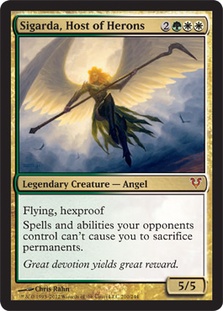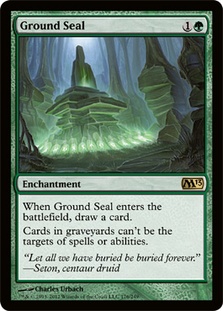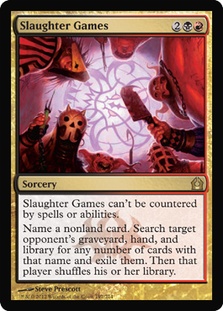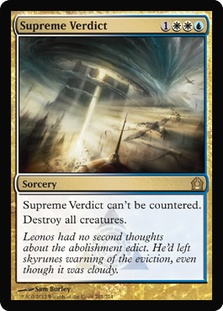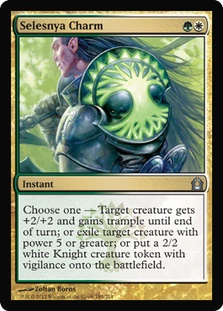I’m not one to make strong statements about cards or formats. People throw these kinds of claims around pretty lightly. To be honest, I still haven’t played that much Standard and could be wrong, but I doubt it. The best card in Standard is Sphinx’s Revelation.*
This is the kind of card people play as a one- or two-of. They think it’s a big, flashy end game spell that doesn’t do anything early.
Those people are doing it wrong.
If you’re playing blue and have access to white mana, which seems pretty likely, there’s a good chance you should be playing four Sphinx’s Revelations.
I tried building some control decks and started with numbers like two or three, and it only took a couple games to realize I always wanted to draw Sphinx’s Revelation.
I tried to build U/W/R Control decks with Thoughtflare as my midgame card draw and Sphinx’s Revelation as the big finish, but it turns out that was stupid. For the same mana, Sphinx’s Revelation nets you the same number of cards and two life. Now, gaining two life isn’t better than Looting twice, but when your deck is full of Sphinx’s Revelations, extra lands are pretty good, so Looting isn’t that important. Moreover, if you’re desperate, you can actually cycle Sphinx’s Revelation for one less mana, and, more importantly, it’s miles better at every additional amount of mana (it’d be close at six except that the three life is a pretty big deal).
Â
Â
Â
This card looks, on the surface, like a tweaked Blue Sun’s Zenith. It has a different upside, but it’s the same basic idea. No. It’s not the same basic idea. The life gain is enormous, especially when you plan to cast lots of them.
You often find yourself playing against other control decks that have random one- and two-power creatures that look to nickel and dime you while you build up your mana. Ordinarily, this kind of pressure would build up. I’ve found that I can ignore it entirely if I’m going to be able to force my Sphinx’s Revelations through.
Speaking of forcing my Sphinx’s Revelations through, people still aren’t playing enough counterspells, and they’re not playing the right ones. Also, even against decks with counterspells, resolving Sphinx’s Revelation for two or three at the end of my own turn has been absurdly easy since they’re built to tap out to play Restoration Angel or Snapcaster targeting Azorius Charm at the end of my turn. Once I resolve Revelation, I’m way ahead.
The absolute power level of Sphinx’s Revelation as in how strong it is as a card in a vacuum is through the roof, but what about contextually in this format at this time?
Wow.
It couldn’t be better.
The format is all Thragtusk mirrors, decks that lose to Thragtusk, and decks that lose to Sphinx’s Revelations and counterspells (Thragtusk mirrors).
If you’re playing Thragtusk, beating the aggressive decks is generally very easy (you have to do more work, but that work isn’t difficult), and when both players have Thragtusks, games almost always go absurdly long. This leads to decks like Omniscience and Epic Experiment being playable.
What if you could have a deck built on the same basic premise, that the game is going to go long and the biggest spell is going to win, except your big spell is an instant that you can cast in the mid game if you have to? Wouldn’t that be better? And instead of the ridiculous support cards that make those big spells actually win, you can just play counterspells. Your instant speed card draw and counterspells mean you beat the other late game trump decks, and the fact that your late game is less absurdly over the top means you’re better against the decks that are trying to go under you.
The Deck
Obviously, I’m saying this with a deck in mind, and that deck is Bant Control. Nothing special, just the deck that’s already been doing well, but my version is built with an actual understanding of the format to play the most of the best cards and to win mirror and semi-mirror matches.
This is where my list is at currently:
Creatures (6)
Planeswalkers (3)
Lands (26)
Spells (25)

This list is inspired by playing games with control decks I’d built before against Andrew Cuneo and learning from the ways in which he smashed me.
Dissipate is the truth. Syncopate, as Andrew explained, isn’t a card you can play in decks that are trying to play a long game. You might stay ahead of them on mana (you also might not), but it’s horrible in counter wars when you’re relying on Syncopate and can’t protect your spells. It gets so bad after the first few turns. Yes, it can counter things for two mana, but outside of Geist of Saint Traft or Geralf’s Messenger when you’re on the draw, that’s not something you really need to do. Remove Soul? It sounds pretty sweet, but what happens when you play against people who know about Sphinx’s Revelation? It has not been going well for my opponents.
The important cards in this deck are the four-ofs, and I could see moving the fourth Dissipate to the sideboard along with the Elixir of Immortality. It lets this deck play like the Diabolic Revelation decks I’d been playing before the better Revelation was printed. The other cards, including Jace, Architect of Thought, are cards I’m trying out that are relatively interchangeable and unimportant. I’m pretty sure you want some sweepers, and Sigarda, Host of Herons, who I just added, has impressed me in early testing
Â
Â
I’m pretty excited about Ground Seal as a maindeck one-of. It’s a recent addition and is a little awkward because it seems like no one on Magic Online plays Unburial Rites, but I like the idea. Ground Seal turns off Snapcaster Mage, Deathrite Shaman, Unburial Rites, Seance, and part of Angel of Serenity. That’s pretty narrow, but Snapcaster still sees a reasonable amount of play. It was actually protecting my graveyard from Deathrite Shaman that really sold me, even though it’s a pretty big corner case where that will matter.
Adding Ground Seal forced me to cut Purify the Grave from my sideboard for Grafdigger’s Cage since those don’t interact well, and there’s a chance Grafdigger’s Cage is better anyway.
Speaking of my sideboard, I should probably start with the weirdest card, Slaughter Games.
The Sideboard
Honestly, I’m so confident this deck is the best deck right now that I’m willing to play some useless dual lands to support a double-splashed sideboard card because it’s the best thing I can do in the mirror match. I was playing Slaughter Games even before other people started playing versions of Bant that are actually threatening in the mirror because I wanted to be ready. Is that inbred and going too far? Absolutely. By all means you can cut them, but it felt dishonest to show you a version without them.
Still, realistically, you should probably play basics over my off-color duals and play some other trump like Curse of Echoes or more counterspells instead.
Â
Â
The seven creatures in my sideboard are a package that I bring in against aggressive decks. Ordinarily, I side in additional removal and could see Sensory Deprivation here, but I think the creatures are harder for those decks to beat. After I side out my ineffective cards for these, the aggressive matchups have been pretty easy.
The Supreme Verdict is there specifically for G/W, which is the aggressive deck that can overpower my creature sideboard.
Ray of Revelation might be too narrow. Maybe it should be a fourth Centaur Healer for the aggro matchups or a Sundering Growth to kill Runechanter’s Pike, but the idea here is that it’s good against other Detention Sphere decks and has some corner cases where it’s awesome. Though now that I think about it, Detention Sphere is pretty bad against me, so it should probably be something else.
The most important note on sideboarding is don’t side out Sphinx’s Revelations. You’ll probably be tempted to cut them against a deck you consider too fast or a deck you think will be able to counter them, but really, leave them in. This is a Sphinx’s Revelation deck, and they always get better after sideboarding (like all card draw).
Cards I’m Not Playing
Tamiyo, the Moon Sage: I could easily see playing Tamiyo. It does roughly what I want to be doing, but the tap ability doesn’t feel that impressive in this format. It’s one of the best answers to Thragtusk, but this deck isn’t really concerned with answering Thragtusk. Most other decks have haste creatures, flash creatures, or large numbers of small creatures, and those aren’t what Tamiyo wants to play against. Also, I really want to minimize my expensive sorcery speed plays. Thragtusk is a necessary evil, but Jace and Tamiyo are often similarly threatening and Jace costs less mana. Still, there’s enough to be said for versatility that I could easily see myself cutting a Jace for a Tamiyo.
Angel of Serenity: This is the big spell a lot of Bant decks are playing over Sphinx’s Revelation. I started with an Angel of Serenity in my deck. When I played my Jarad deck, I was impressed by how unbeatable Angel of Serenity was, so I thought it’d probably be a good card. It’s a fine card. It’s a powerful thing to do with a lot of mana, but at the end of the day, it’s not good enough to warrant space in the deck. My late game is good enough without it. Sigarda, Host of Herons is a much better Angel for this deck.
Oblivion Ring: The theoretical upside here is that it can hit Detention Sphere, but against people with Detention Sphere, Detention Sphere has the upside that it can’t be hit by their Spheres. In other places, Sphere is much better. I wouldn’t play Oblivion Ring over the fourth Detention Sphere in decks with easy access to blue mana.
Alchemist’s Refuge: This effect seems really sweet, but colorless lands are really hard to justify in a deck with such strict color requirements. I’m already minimizing my sorcery speed plays, and activating Alchemist’s Refuge at the end of their turn to play a Thragtusk gives them a window to resolve a big Sphinx’s Revelation. I much prefer Ghost Quarter as my colorless land.
Â
Â
Selesnya Charm: This is appealing only as an answer to Thundermaw Hellkite. If that becomes a serious problem, I could see using this to help fight it. It also has nice synergy with Trostani when I board it in.
Centaur Healer (main): Unnecessary at this point.
Snapcaster Mage: Without one- and zero-mana cantrips, this guy’s too much of a mid to late game card, and the body doesn’t have enough upside here to warrant it.
Restoration Angel: I’m playing one, but that barely counts. I’ve been happy with the one I have, but with only Thragtusk to Blink, it’s generally just a 3/4 flash flier. That’s fine, but not something I want a lot of against an unknown opponent. It makes a lot more sense in the decks that are playing Centaur Healer main, but this is an evolution designed to prey on those by not playing such low impact cards since I’ve found having them main to be unnecessary against the decks where they’re good.
Ranger’s Path: This is one of the last cards I cut, so I might as well bring it up. I wasn’t disappointed with it as a one-of that supercharges my Sphinx’s Revelations, but as I’ve lowered the curve on my other spells, it felt too narrow because it’s only good if I can resolve a Sphinx’s Revelation after it. It’s too much mana to justify tapping on my turn for the effect.
I think this deck very well positioned, but I’m only 12-6 with it on Magic Online, which is good but not great, though that’s tracking from my first version as I’ve improved the deck. As I mentioned earlier, most of the numbers are still flexible.
The most important takeaway here should be that Farseek / Thragtusk / Sphinx’s Revelation is my pick for the best shell in Standard at the moment. Even the U/W/R decks should be playing more Sphinx’s Revelations than they are because it’s an absurd card.
Thanks for reading,
Sam
@samuelhblack on Twitter
* The best card in Standard is Thragtusk, and it’s not remotely close. Taking that as a given, the next best card and the most underplayed card is Sphinx’s Revelation. You really didn’t want to read an article about how Thragtusk is the best card anyway.


